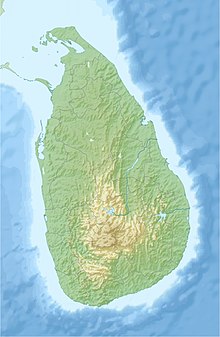Kumana National Park
| Kumana National Park | |
|---|---|
|
IUCN category II (national park)
|
|

Kumana National Park aerial view near Kudumbigala sanctuary
|
|
| Kumana National Park | |
| Location | Eastern Province, Sri Lanka |
| Nearest city | Hambantota |
| Coordinates | 6°30′47″N 81°41′16″E / 6.51306°N 81.68778°ECoordinates: 6°30′47″N 81°41′16″E / 6.51306°N 81.68778°E |
| Area | 35,664 ha |
| Established | 20 January 1970 |
| Governing body | Department of Wildlife Conservation |
Kumana National Park in Sri Lanka is renowned for its avifauna, particularly its large flocks of migratory waterfowl and wading birds. The park is 391 kilometres (243 mi) southeast of Colombo on Sri Lanka's southeastern coast. Kumana is contiguous with Yala National Park. Kumana was formerly known as Yala East National Park, but changed to its present name in 5 September 2006.
The park was closed from 1985 to March 2003 because of the LTTE (Liberation Tigers of Tamil Elam) attacks. It was also affected by the Boxing Day tsunami in 2004.
Kumbukkan Oya forms the southern boundary of the national park. Some 20 lagoons and tanks support the extensive birdlife of the national park. The lagoons are shallow with depths less than 2 metres (6.6 ft). Kumana villu is subject to occasional inundation with seawater. The elevation of the area ranges from sea level to 90 metres (300 ft). The mean annual temperature is 27.30 °C (81.14 °F) and the area receives 1,300 millimetres (51.18 in) of annual rainfall.
The park's wetland areas are surrounded by dry zone tropical thorn forest. The inland forest's flora is dominated by Manilkara hexandra (Sinhalese "palu"), Hemicyclea sepieria, Bauhinia racemosa, Cassia fistula ("ehela"), Chloroxylon swietenia ("burutha"), and Salvadora persica species. The dominant tree of the Kumana villu is Sonneratia caseolaris, while Typha angustifolia is the dominant reed. Terminalia arjuna trees dominate the riverine forests along the Kumbukkan Oya. The common aquatic plants of the swamp are colourful Ludwigia spp., Nelumbo nucifera, Nymphaea pubescens, Aponogeton spp. and Neptunia oleracea.
...
Wikipedia

